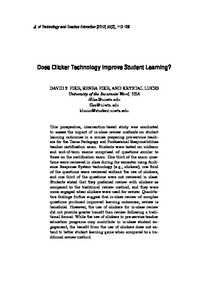 Diese Seite wurde seit 5 Jahren inhaltlich nicht mehr aktualisiert.
Unter Umständen ist sie nicht mehr aktuell.
Diese Seite wurde seit 5 Jahren inhaltlich nicht mehr aktualisiert.
Unter Umständen ist sie nicht mehr aktuell.
 Zusammenfassungen
Zusammenfassungen
This prospective, intervention-based study was conducted
to assess the impact of in-class review methods on student
learning outcomes in a course preparing pre-service teachers
for the Texas Pedagogy and Professional Responsibilities
teacher certification exam. Students were tested on midterm
and end-of-term exams comprised of questions similar to
those on the certification exam. One third of the exam questions
were reviewed in class during the semester using Audience
Response System technology (e.g., clickers), one third
of the questions were reviewed without the use of clickers,
and one third of the questions were not reviewed in class.
Students stated that they preferred review with clickers as
compared to the traditional review method, and they were
more engaged when clickers were used for review. Quantitative
findings further suggest that in-class review of complex
questions produced improved learning outcomes; review is
beneficial. However, the use of clickers for in-class review
did not provide greater benefit than review following a traditional
format. While the use of clickers in pre-service teacher
education programs may contribute to in-class student engagement,
the benefit from the use of clickers does not extend
to better student learning gains when compared to a traditional
review method.
Von David S. Fike, Renea Fike, Krystal Lucio im Text Does Clicker Technology Improve Student Learning? (2012)  Dieser Text erwähnt ...
Dieser Text erwähnt ...
 Begriffe KB IB clear | Classroom response systemClassroom response system
, LehrerInnen-Bildungteacher training
,  Lernen Lernen learning learning
|
 Dieser Text erwähnt vermutlich nicht ...
Dieser Text erwähnt vermutlich nicht ... 
 Nicht erwähnte Begriffe | LehrerIn |
 Volltext dieses Dokuments
Volltext dieses Dokuments
 |  Does Clicker Technology Improve Student Learning?: Artikel als Volltext ( Does Clicker Technology Improve Student Learning?: Artikel als Volltext ( : :  , 111 kByte; , 111 kByte;  : :  2021-03-21) 2021-03-21) |
 Anderswo suchen
Anderswo suchen 
 Beat und dieser Text
Beat und dieser Text
Beat hat Dieser Text während seiner Zeit am Institut für Medien und Schule (IMS) ins Biblionetz aufgenommen. Beat besitzt kein physisches, aber ein digitales Exemplar. Eine digitale Version ist auf dem Internet verfügbar (s.o.). Aufgrund der wenigen Einträge im Biblionetz scheint er es nicht wirklich gelesen zu haben. Es gibt bisher auch nur wenige Objekte im Biblionetz, die dieses Werk zitieren.










 Biblionetz-History
Biblionetz-History